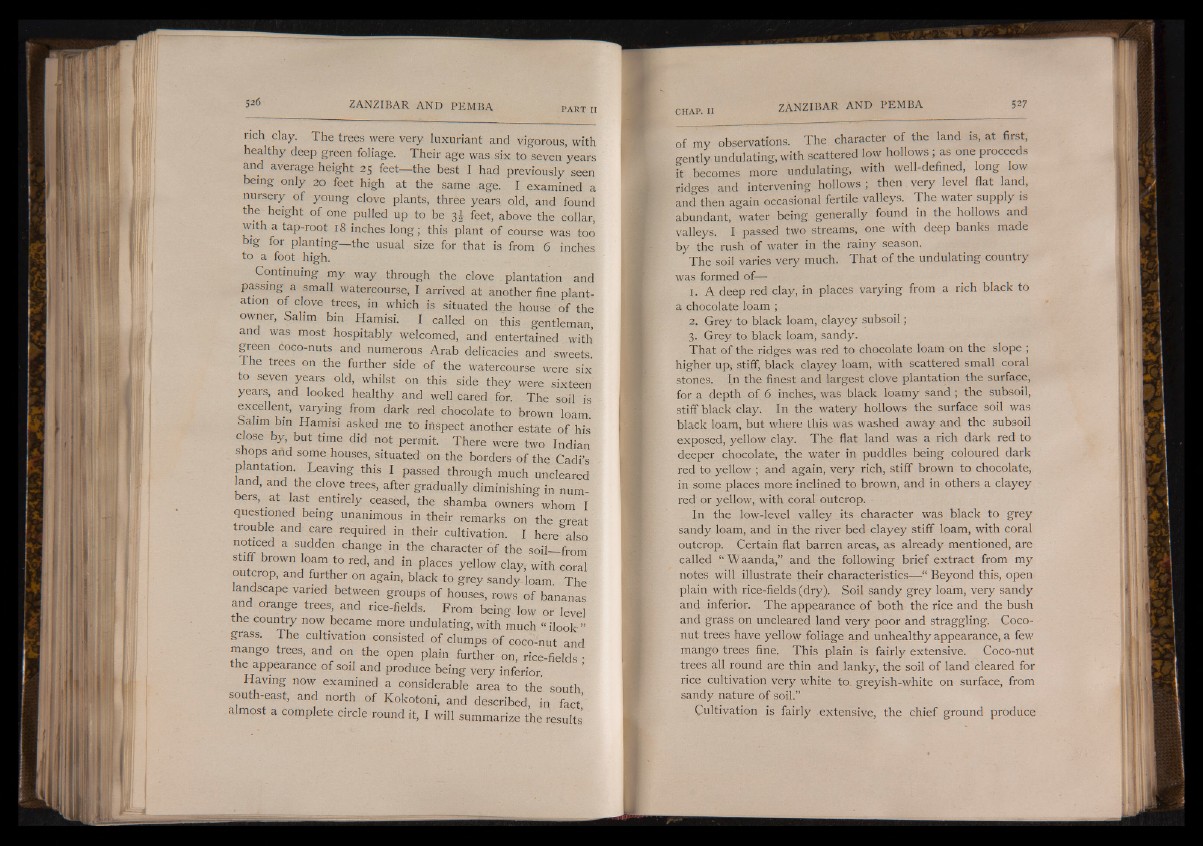
rich clay. The trees were very luxuriant and vigorous, with
healthy deep green foliage. Their age was six to seven years
and average height 25 feet— the best I had previously seen
being only 20 feet high at the same age. I examined a
nursery of young clove plants, three years old, and found
the^ height of one pulled up to be 3! feet, above the collar,
with a tap-root 18 inches long; this plant of course was too
big for planting— the usual size for that is from 6 inches
to a foot high.
Continuing my way through the clove plantation and
passing a small watercourse, I arrived at another fine plantation
of clove trees, in which is situated the house of the
owner, Salim bin Hamisi. I called on this gentleman
and was most hospitably welcomed, and entertained with
green coco-nuts and numerous Arab delicacies and sweets.
he trees on the further side of the watercourse were six
to seven years old, whilst on this side they were sixteen
years, and looked healthy and well cared for. The soil is
excellent, varying from dark red chocolate to brown loam.
Salim bin Hamisi asked me to inspect another estate of his
close by but time did not permit. There were two Indian
shops and some houses, situated on the borders of the Cadi’s
plantation, h a v in g this I passed through much uncleared
land, and the clove trees, after gradually diminishing in numbers
at last entirely ceased, the shamba owners whom I
questioned being unanimous in their remarks on the great
trouble and care required in their cultivation. I here also
noticed a sudden change in the character of the soil— from
stiff brown loam to red, and in places yellow clay, with coral
outcrop, and further on again, black to grey sand/loam The
landscape varied between groups of houses, rows of bananas
and orange trees, and rice-fields. From being low or level
the country now became more undulating, with much “ ilook”
grass. The cultivation consisted of clumps of coconut and
mango trees, and on the open plain further on, rice-fields ■
the appearance of soil and produce being very inferior
Having now examined a considerable area to the south
south-east, and north of Kokotoni, and described, in fact’
almost a complete circle round it, I will summarize the results
of my observations. The character of the land is, at first,
gently undulating, with scattered low hollows ; as one proceeds
it becomes more undulating, with well-defined long low
ridges and intervening hollows ; then very level flat land,
and then again occasional fertile valleys. The water supply is
abundant, water being, generally found in the hollows and
valleys. I passed two streams, one with deep banks made
by the rush of water in the rainy season.
The soil varies very much. That of the undulating country
was formed of—
1. A deep red clay, in places varying from a rich black to
a chocolate loam ;
2. Grey to black loam, clayey subsoil;
3. Grey to black loam, sandy.
That of the ridges was red to chocolate loam on the slope ;
higher up; stiff, black clayey loam, with scattered small coral
stones. In the finest and largest clove plantation the surface,
for a depth of 6 inches, was black loamy sand; the subsoil,
stiff black clay. In the watery hollows the surface soil was
black loam, but where this was washed away and the subsoil
exposed, yellow clay. The flat land was a rich dark red to
deeper chocolate, the water in puddles being coloured dark
red to yellow ; and again, very rich, stiff brown to chocolate,
in some places more inclined to brown, and in others a clayey
red or yellow, with coral outcrop.
In the low-level valley its character was black to grey
sandy loam, and in the river bed clayey stiff loam, with coral
outcrop. Certain flat barren areas, as already mentioned, are
called ‘‘ W aanda,” and the following brief extract from my
notes will illustrate their characteristics— $ Beyond this, open
plain with rice-fields (dry). Soil sandy grey loam, very sandy
and inferior. The appearance of both the rice and the bush
and grass on uncleared land very poor and straggling. Coconut
trees have yellow foliage and unhealthy appearance, a few
mango trees fine. This plain is fairly extensive. Coco-nut
trees all round are thin and lanky, the soil of land cleared for
rice cultivation very white to. greyish-white on surface, from
sandy nature of soil.”
Cultivation is fairly extensive, the chief ground produce